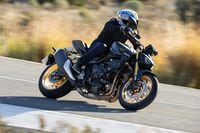No doubt about it--we were genuinely surprised when Yamaha told us its new FZ6 would be offered in America in 2004. After all, this bike's European intentions couldn't be more obvious if its fairing were carved from brie. Everything about it, from the upright ergos to the sensible colors to the factory centerstand, screams Euro market. Indeed, the FZ6 was designed specifically for Continental riders; this is the "next-generation" version of Yamaha's best-selling Fazer 600, a bike with total sales in Europe of nearly 83,000 units over the last five years. We took one look at the spy shots that leaked out early and thought: File this baby next to the TRX850 and other cool bikes we'll never see Stateside.
Midsized standards might be the most popular category in Europe, but in America it's traditionally a sales Black Hole. (Remember Honda's Hawk GT and CB1?) Until now, that is. The success of Suzuki's SV650, and strong sales of Yamaha's larger-displacement-but-similar-concept FZ1 (which Yamaha says is now the number-one-selling standard motorcycle in America) was enough to convince Yamaha to roll the dice and bring a few FZ6s across the pond to test the middleweight market. (Honda's jumped in, too, with its new 599--a.k.a. the Euro-spec Hornet 600.)
We're huge fans of Yamaha's overachieving FZ1, so when presented with the prospect of a similarly sublime FZ6--a real-world R6, if you will--we were psyched. Despite the fact that the FZ6 comes with budget-spec suspension (unlike the superbly suspended FZ1), it's still an exciting motorcycle that fills a unique niche in the U.S. market. So it was with much enthusiasm that we traveled to Innsbruck, Austria, the heart of the Tyrolean Alps, for a first ride.
Even though it's built as a price-point bike (Yamaha says it will be priced competitively with Suzuki's $6299 SV650S), you'd never guess the FZ6's budget nature at a glance. Styling is clean and cutting edge, with a sculpted, five-gallon tank, a compact under-tail muffler and a broad fairing topped with a trick, one-piece transparent windscreen/upper. Finishes are superb--the main frame spars are made using Yamaha's proprietary die-casting technology, so these pieces are visually complex, with smooth surfaces and no welds. All the bodywork (save the tank) is resin-molded in color, along with the resin muffler guards, for a durable, fade- and scratch-proof appearance, and the now-exposed R6 engine has been cleaned up with a new cylinder-head cover and a sexed-up radiator.
Climbing aboard, everything feels as good as it looks. Yamaha's engineers paid careful attention to optimizing ergonomics--the original design brief explicitly specified "a function-oriented middleweight that emphasizes [rider] fit." Compared with the old Fazer 600, the rider has been moved 8mm forward, while at the same time the bar has been moved 13mm closer and the seat-to-peg distance opened up 13mm for more legroom. Although the underseat exhaust and cutaway bodywork make the bike look tall in photos, the seat height is a reasonable 31 inches, and the bike feels compact beneath you.
From the saddle you'll never confuse the FZ6 with the sportier SV650S. As you can see from the pictures, the FZ6 riding position is pure sit-up-and-beg, giving you a commanding view of the roadway ahead--perfect for the inner-city slalom, or, in this case, surveying the eye-popping alpine scenery. Further accentuating the FZ6's all-around abilities is the supremely functional fairing. The wide screen blocks plenty of air, and the flow over your shoulders is exceptionally smooth at all speeds. The only fly in the ergo-ointment is a too-soft, less-than-supportive seat. The bolt-upright body position puts a lot of weight on your rear, and butt-burn sets in after about 80 miles.
The best way to eliminate this is to find some twisty roads that allow you to move around on the bike and give your rump a rest. We found plenty of these, and for the most part this little Fizzer comported itself well. Frame geometry is middle-of-the-roadish, with a 56.7-inch wheelbase, 25 degrees of rake and 97.5mm (3.8 inches) of trail. All this, combined with a longer (590.0mm, compared with 516.5mm on the old Fazer 600) swingarm in the back, inspires calm, neutral handling. The high, wide bar compensates for the lazy front-end numbers and manages a reassuring, easy-to-steer feel, and relaxed geometry makes the bike stable and mostly immune to odd inputs such as midcorner braking and overeager throttle applications. It's a confidence-inspiring ride.
Yamaha reps were adamant that FZ6 buyers, unlike FZ1 enthusiasts, were likely to be very price sensitive, and as such concessions needed to be made to keep costs down. Accordingly, the conventional 43mm fork is completely nonadjustable, and the rear monoshock (a linkless design acted on directly by the swingarm) is adjustable for preload only. This, predictably, is the FZ6's weakest link. Although well-damped (better, for example, than the similarly nonadjustable struts on the SV650), the FZ6 suspension is typically undersprung and can be overwhelmed once you start pushing the pace, especially on rough roads.
Bargain-bin suspenders aside, the rest of the chassis is good stuff. The FZ6 rolls on R6-style five-spoke wheels that carry a 120/70 ZR17 tire up front and a meaty 180/55 ZR17 in the rear, so you'll have no shortage of good tire choices available when the stock skins (Dunlop Sportmax D252s or Bridgestone 020s) wear out. The brakes are perfectly serviceable, with dual R6-style 298mm front rotors, and a 245mm rotor in the rear. While these leave a bit to be desired with regard to initial bite and overall feel, they offer plenty of braking power and are mostly fade resistant.
Good brakes are good news because the FZ6 has motor--likely more motor than anything else in the middleweight standard class. The little Fizzer's powerplant is built around the world-beater R6 mill, retuned here for better power at lower, more street-specific revs. The bore-and-stroke dimensions, combustion-chamber shape, forged pistons, valves, crank and linerless, direct-plated cylinders are all identical to the R6, though it does diverge internally in a few significant areas: reshaped camshafts, reconfigured inlet and exhaust ports, and a slightly lower (down 0.2) compression ratio.
The FZ's fuel injection debuts a unique "group-injection" system used for the first time by Yamaha. The 36mm throttle bodies are "paired," so the number one and four injectors fire in unison, as do two and three. This is where things get complicated: Each four-jet, bidirectional injector splits the fuel charge for each cylinder into two separate but equal injections. The injectors then fire 50 percent fuel volume every 360 degrees of crank rotation (two shots per combustion cycle, just before the piston reaches TDC each time). Sounds complicated, but Yamaha says group injection actually simplifies the injection mechanism, allowing it to do away with the cam position sensor, and offers advantages with atomization and mixing of the fuel/air mixture. The system is monitored by a new, more compact ECU, and is fed by a 6.3-liter, downdraft airbox designed to further improve midrange response. The exhaust header leads into an underseat system that incorporates a two-way catalytic converter and a single muffler (don't let the twin-pipe-look outlet fool you). Yamaha claims 98 crankshaft horses at 12,000 rpm (1000 rpm lower than the R6 power peak); feels like low 80s on ye old derriere dyno.
On the open road the reconfigured R6 motor works well--there's usable power as low as 5500 rpm, and things remain strong all the way to the double digits, with enough of the old, rev-happy R6 character to keep your blood flowing. The only bother is at the bottom of the rev range--injection innovation aside, there remains a bad stumble coming off of closed throttle that made for some less-than-smooth corner exits in those impossibly tight alpine switchbacks.
Yamaha will take a page from the FJR1300 playbook and bring a relatively small number of FZ6s (just a few per dealer) to the States this year. In recent years the middleweight standard category was slim pickins; just the SV, the Triumph Speed Four and the soon-to-be-departed (an educated guess here) Bandit 600. Suddenly, this category is crowded, with new entries such as the FZ6, Honda's new 599 and the middleweight-plus Kawasaki Z750. All strong bikes, but we're betting few of these will match the comfort, versatility and sheer functionality of the FZ6.
YAMAHA FZ6
_PRICE_
MSRP: N/A
_ENGINE_
Type: l-c inline-four
Valve arrangement: dohc, 16v
Displacement: 600cc
Transmission: 6-speed
_CHASSIS_
Weight: 423 lb. (fueltank empty)
Fuel capacity: 5.1 gal.
Wheelbase: 56.7 in. (1440mm)
Seat height: 31.5 in. (795mm)
Yamaha FZ6: A Second Opinion
With an R6-based engine and a modern (indeed, forward-thinking) aluminum frame, the FZ6 clouts to the point of seeing stars its only direct U.S. competition (Suzuki's Bandit 600S) in every category that matters: power, weight, stiffness, handling and handsome good looks. That may be why the Suzuki isn't hanging around for the fight; the 600S is leaving town in 2004.
Priced along the lines of the Suzuki SV650S ($6300, give or take), the FZ6 packs more horsepower (albeit less torque) in a larger package that feels like a 7/8-scale FZ1 ergonomically. This will be good news for those who tried on a new-generation SV and found it cramped. Once Yamaha gets a handle on the fuel injection's tendency to snatch and jerk at low speeds--there were furrowed brows all around the Yamaha contingent after even the most doltish member of the press called attention to the malady--the FZ6 will no doubt prove to be one of those great crossover bikes, popular with experienced riders (thanks to the fine spread of power) and newbies (for the moderate seat height and docile, predictable handling). More telling is that the FZ6, like the cult-favorite SV, utterly transcends its budget-bike roots--damping-rod fork, soft suspension, low-tech brakes, Bakelite-compound OE Dunlops--to be far more entertaining than it has a right to be. --Marc Cook
















/cloudfront-us-east-1.images.arcpublishing.com/octane/2WF3SCE3NFBQXLDNJM7KMXA45E.jpg)
/cloudfront-us-east-1.images.arcpublishing.com/octane/G4MG6OUCJNBSHIS2MVVOTPX65E.jpg)
/cloudfront-us-east-1.images.arcpublishing.com/octane/IIGGWFOTOJGB7DB6DGBXCCMTDY.jpg)
/cloudfront-us-east-1.images.arcpublishing.com/octane/QSTCM6AVEZA5JJBUXNIQ3DSOF4.jpg)
/cloudfront-us-east-1.images.arcpublishing.com/octane/U4I7G625B5DMLF2DVIJDFZVV6M.jpg)
/cloudfront-us-east-1.images.arcpublishing.com/octane/B6XD6LS6IVCQPIU6HXDJSM3FHY.jpg)
/cloudfront-us-east-1.images.arcpublishing.com/octane/ICL63FEDDRDTTMINYICCEYGMDA.jpg)
/cloudfront-us-east-1.images.arcpublishing.com/octane/FCGZHQXRBZFLBAPC5SDIQLVF4I.jpg)
/cloudfront-us-east-1.images.arcpublishing.com/octane/WNOB6LDOIFFHJKPSVIWDYUGOPM.jpg)

/cloudfront-us-east-1.images.arcpublishing.com/octane/X33NU3E525ECRHXLNUJN2FTRKI.jpg)
/cloudfront-us-east-1.images.arcpublishing.com/octane/6KKT5NNL2JAVBOXMZYS5ZO76YA.jpg)
/cloudfront-us-east-1.images.arcpublishing.com/octane/J5RKG5O455GMPGQRF2OG6LRT7A.jpg)
/cloudfront-us-east-1.images.arcpublishing.com/octane/GX2CIZKQVRH2TATDM26KFG2DAE.jpg)
/cloudfront-us-east-1.images.arcpublishing.com/octane/ZWIDYSAKQZHD5BHREMQILXJCGM.jpg)
/cloudfront-us-east-1.images.arcpublishing.com/octane/CYUHJZCTSJCH3MRAQEIKXK7SCQ.jpg)
/cloudfront-us-east-1.images.arcpublishing.com/octane/LKOFINY56FCXJCANJ5M7ZDQUBY.jpg)
/cloudfront-us-east-1.images.arcpublishing.com/octane/4NBPDACMWJH63JQYJVK3QRBDZI.jpg)
/cloudfront-us-east-1.images.arcpublishing.com/octane/KKHQHRR3FJGX7H2IPU6RALMWG4.jpg)

/cloudfront-us-east-1.images.arcpublishing.com/octane/5IOFS5JAE5FOXMNA23ZRAVVYUU.jpg)
/cloudfront-us-east-1.images.arcpublishing.com/octane/CGXQ3O2VVJF7PGTYR3QICTLDLM.jpg)

/cloudfront-us-east-1.images.arcpublishing.com/octane/OQVCJOABCFC5NBEF2KIGRCV3XA.jpg)